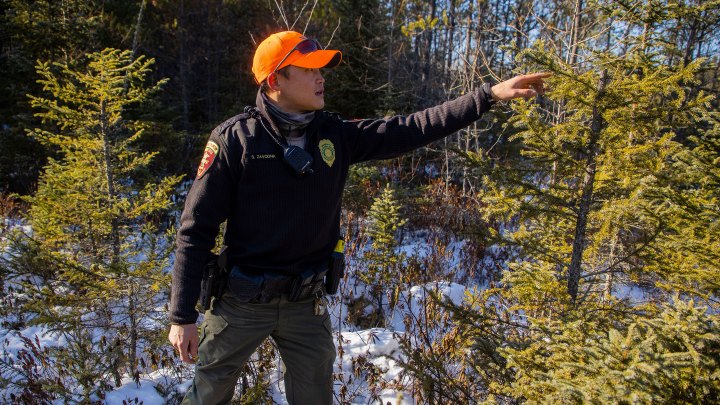
Spruce top thieves illegally cutting a northwoods cash crop
Spruce top thieves illegally cutting a northwoods cash crop

Minnesota Department of Natural Resources Conservation Officer Shane Zavodnik recently hopped through a snowy bog a few miles outside Eveleth, Minnesotta, struggling to keep his boots dry.
Then, he spotted the telltale signs of an unusual crime. Every few feet, he pointed to the tops of young spruce trees, five to eight feet tall, with their tops hacked off.

The evergreen tops of these small, immature spruce trees that sprout out of the soggy bogs of northeastern Minnesota’s boreal forest are all the rage in home holiday decor. When potted up they look like miniature Christmas trees, and are popular on tabletops or on suburban front porches.
Northern Minnesota is home to a thriving cottage industry of harvesters and buyers. They supply a growing holiday greenery market, from birch logs to spruce tops to balsam boughs, that are used to make garlands and wreaths.
But this year, suppliers from Canada haven’t been able to sell across the border because of the COVID-19 pandemic. So spruce thieves have stepped in to help fill part of the gap.
“We’ve been getting spruce top theft complaints since the middle of September, and it’s just consistent and constant,” said Zavodnik. “We’ve had cases from International Falls all the way down to the Twin Cities, including out-of-state buyers as well.”

The people illegally cutting the spruce tops, he said, are going to great lengths to avoid detection. They work late at night. They use fluorescent tape to mark their trails into the spruce swamps, so they don’t get lost trying to come out. He said most of those caught have had prior criminal records.
It’s hard, wet, cold work, but potentially lucrative. Zavodnik said they can sell the tops for as much as a dollar a piece to unlicensed buyers.
“On any given night, two people, in a 7-8 hour period, can cut roughly 1,000 tops,” he said.
So far this season conservation officers have seized well over 15,000 spruce tops. That’s the most they’ve ever confiscated in a year, Zavodnik said. Still, it’s a tiny fraction of the overall, legal market.
Holiday greenery makes up a $23 million industry in Minnesota, according to a Minnesota DNR report in 2003. The impact of the illegal harvest?
“It’s a rounding error, it doesn’t even register,” said Sean Timonen, who co-owns a family business called Black Spruce Holdings near Barnum.
This year, with his dad, his brother and a couple dozen crew members, the Timonens cut 1.1 million spruce tops. That’s enough to fill about 50 big, refrigerated trucks.
The Timonens buy permits from state and federal landowners, or pay private landowners for access to their trees.
They’ve even designed and fabricated their own fleet of specialized vehicles with tracks instead of wheels that help spread out their weight, to prevent damage to sensitive spruce bogs.

The business they started as a side hustle 20 years ago now sells to commercial greenhouses, which use the spruce tops to make decorative holiday pots that are sold nationwide.
“Our largest account took over 400,000 tops,” Timonen said. “That’s many, many pots that are being made [and sold] to retail chains across the country.”
The DIY market is also booming, spurred on by social media like Pinterest and Instagram.
A lot of people wonder whether cutting spruce tops harms the trees. But when done properly, the tree responds by “throwing up a new leader of growth,” said Kristen Bergstrand with the Minnesota DNR’s forestry division. “So it can make the tree not have as good a form,” but it doesn’t kill or damage the trees.
In fact, after five to ten years, she said people can harvest the tops again.
There’s a lot happening in the world. Through it all, Marketplace is here for you.
You rely on Marketplace to break down the world’s events and tell you how it affects you in a fact-based, approachable way. We rely on your financial support to keep making that possible.
Your donation today powers the independent journalism that you rely on. For just $5/month, you can help sustain Marketplace so we can keep reporting on the things that matter to you.











